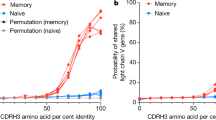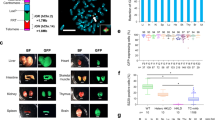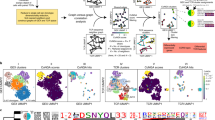Abstract
H–2K, H–2D, H–2I, Qa-2 and TL are all members of a closely related family of cell-surface glycoproteins. The H–2 molecules (major histocompatibility antigens) are extremely polymorphic, expressed on almost all cell types and play an important part in graft rejection1–4. In contrast, Qa-2 and TL are much less polymorphic, and have a limited tissue distribution4,5. Nevertheless, all these molecules are similar in that they consist of two chains, one of which is the invariant β2-microglobulin (molecular weight (MW) 11,500), the other a 45,000-MW glycopolypeptide2,6–10. The 45,000-MW H–2K and H–2D map within 0.3 centimorgans of each other in the major histocompatibility complex (MHC) on chromosome 17 (ref. 1). The Qa-2 and TL chains are encoded by genes in the closely linked Tla region. Recently, recombinant DNA techniques have been used to study the family of genes encoding H–2-like molecules11–14. The finding that cloned H–2 cDNA hybridizes to 10–20 restriction fragments of genomic DNA has led to the conclusion that there are 10–20 H–2-like genes in the murine genome11,12. Here we present evidence that most of these genes are encoded on chromosome 17 and that at least three H–2-like genes map outside the MHC in the Tla region. We also confirm and provide further evidence that there are 10 to 15 H–2-like genes in the mouse genome.
This is a preview of subscription content, access via your institution
Access options
Subscribe to this journal
Receive 51 print issues and online access
$199.00 per year
only $3.90 per issue
Buy this article
- Purchase on Springer Link
- Instant access to full article PDF
Prices may be subject to local taxes which are calculated during checkout
Similar content being viewed by others
References
Klein, J. Biology of the Mouse Histocompatibility Complex, 1–620 (Springer, Berlin, 1975).
Snell, G. D., Dausset, J. & Nathenson, S. Histocompatibility, 1–401 (Academic, New York, 1976).
Klein, J. Science 203, 516–521 (1979).
Flaherty, L. in The Role of the Major Histocompatibility Complex in Immunobiology (ed. Dorf, M. E.) 33–58 (Garland STPM, New York, 1980).
Flaherty, L. in Origins of Inbred Mice (ed. Morse, H. C. III) 409–422 (Academic, New York, 1980).
Michaelson, J., Flaherty, L., Vitetta, E. & Poulik, M. J. exp. Med. 145, 1066–1070 (1977).
Stanton, T. H. & Hood, L. Immunogenetics 11, 309–318 (1980).
Michaelson, J. Immunogenetics 13, 167–171 (1981).
Silver, J. & Hood, L. Nature 249, 764–765 (1974).
Rask, L., Lindblom, J. B. & Peterson, P. A. Nature 249, 833–834 (1974).
Cami, B., Bregegere, F., Abastado, J. P. & Kourilsky, P. Nature 291, 673–675 (1981).
Steinmetz, M. et al. Cell 24, 125–134 (1981).
Ploegh, H. L., Orr, H. T. & Strominger, J. L. Proc. natn. Acad. Sci. U.S.A. 77, 6081–6085 (1980).
Sood, A. K., Pereira, D. & Weissman, S. M. Proc. natn. Acad. Sci. U.S.A. 78, 616–620 (1981).
Smiley, J. R., Steege, D. A., Juricek, D. K., Summers, W. P. & Ruddle, F. H. Cell 15, 455–468 (1978).
Steinmetz, M. et al. Cell 25, 683–692 (1981).
Klein, J., Flaherty, L., VandeBerg, J. L. & Shreffler, D. C. Immunogenetics 6, 459–512 (1978).
Messing, J., Crea, R. & Seeburg, P. H. Nucleic Acids Res. 9, 309–321 (1981).
Hansen, J. N., Pheiffer, B. H. & Boehnert, J. A. Analyt. Biochem. 105, 192–201 (1980).
Ralph, P. J. Immun. 110, 1470–1475 (1973).
Southern, E. M. J. molec. Biol. 8, 503–517 (1975).
Seidman, J. G., Leder, A., Nau, M., Norman, B. & Leder, P. Science 202, 11–17 (1978).
Wahl, G. M., Stern, M. & Stark, G. R. Proc. natn. Acad. Sci. U.S.A. 76, 3683–3687 (1979).
Evans, G. A., Margulies, D. H., Qzato, K., Camerini-Otero, R. D. & Seidman, J. G. Proc. natn. Acad.Sci. U.S.A. (in the press).
Author information
Authors and Affiliations
Rights and permissions
About this article
Cite this article
Margulies, D., Evans, G., Flaherty, L. et al. H–2-like genes in the Tla region of mouse chromosome 17. Nature 295, 168–170 (1982). https://doi.org/10.1038/295168a0
Received:
Accepted:
Issue Date:
DOI: https://doi.org/10.1038/295168a0
This article is cited by
-
Linkage of the mouse Hsp84 heat shock protein structural gene to the H-2 complex
Immunogenetics (1989)
-
Family organization of mouse H-2 class I genes
Immunogenetics (1985)
-
Five serologically distinguishable Dq region molecules
Immunogenetics (1984)
-
A new determinant, Qa-m208, detected on T lymphocytes and transfected L cells by a Kb-specific monoclonal antibody
Immunogenetics (1984)
-
The structure of a mutant H–2 gene suggests that the generation of polymorphism in H–2 genes may occur by gene conversion-like events
Nature (1983)
Comments
By submitting a comment you agree to abide by our Terms and Community Guidelines. If you find something abusive or that does not comply with our terms or guidelines please flag it as inappropriate.



